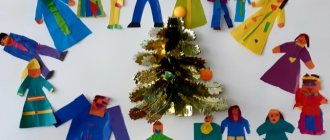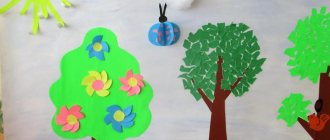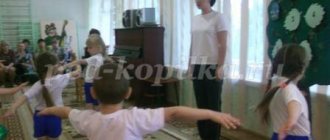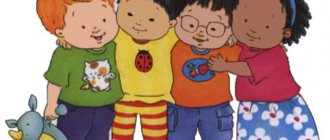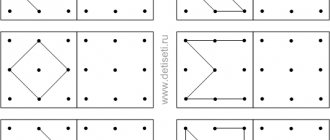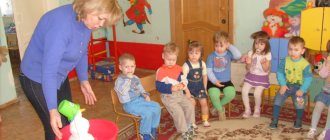Preparatory group. Senior preschool age. Children 6-7 years old
Summary of a lesson in a speech therapy group preparatory to school on research activities “Creating a greenhouse” Lesson in a speech therapy group preparatory to school on research activities “Creating a greenhouse”
.
Goal: To create conditions for research activities , to teach how to make a greenhouse from waste material, to care for plants in various conditions, to educate...
Abstract of the OOD on educational and research activities “Cute ink” in the preparatory group CONSPECT ORGANIZED EDUCATIONAL ACTIVITIES ON COGNITIVE AND RESEARCH ACTIVITIES “SYMPATHETIC ( INVISIBLE)
INK" IN THE PREPARATORY GROUP Educator: Khusainova A. M. Educational area: Cognitive development.
Experimental research …
Summary of an open lesson in the preparatory group
While walking, we often observe air (trees sway, clouds run)
.
We don't see air
, but we can feel it.
Experience 4. “Boats”
Educator: today I invite you to play the role of the breezes. I have boats and basins of water.
Lower the boats into the water. Children blow on the boats, they float. This is how real ships move thanks to the wind. What happens to a ship if there is no wind? What if the wind is very strong? A storm begins, and the ship may suffer a real wreck.
Experiment 5. “Magic Bubbles”
you can draw with
. For drawing we will need soapy colorful water, cocktail tubes and album sheets.
We take a cocktail straw and begin to foam the soapy water (we blow into the straw so that bubbles rise in the jar. You cannot drink such water). When the foam has risen, take the paper and lean it against the soap foam. We get these colorful soap bubbles. Let us give them to Dunno.
Dunno: thank you guys, I learned a lot about air
! I'll go tell my friends about this, goodbye!
Educator: Our laboratory is closing. What did we learn about air
?
(Answers)
What did you like?
(Answers)
. Well done, you were all attentive and observant today, like real scientists. Take off your aprons and hats and play with the balls that Dunno brought.
Abstract of educational activities in the preparatory school group for the development of cognitive and research activities.
Topic: “Air is invisible.”
Burdyukova L.I.
Target:
development of cognitive and research activities of children in the process of conducting elementary experiments with air.
Tasks:
educational:
- summarize previously acquired knowledge about the properties of air,
— clarify the idea that wind is the movement of air;
- contribute to the mastery of some methods of air detection.
developing
- develop curiosity, observation, mental activity, speech, - develop the ability to draw conclusions based on the results of observations and experiments.
educational:
- to cultivate an interest in understanding the world around us and a desire to explore it in accessible ways.
Integration of educational areas:
cognitive development, speech development, social and communicative development, physical development.
Material and equipment:
a computer, plastic bags, some of them with holes invisible to the eye, a glass, a paper napkin, a sponge, a bowl of water.
Preliminary work:
conversation about air, its importance for all life on the planet, watching the wind on a walk, reading K. Ushinsky’s story “Wind and Sun”.
MAGAZINE Preschooler.RF
Summary of educational activities with children of the preparatory group for school in accordance with the Federal State Educational Standard for Education using ICT. Cognitive and research activities of older preschoolers. "Country of Time".municipal preschool educational institution "Kindergarten No. 12 "Romashka" of compensatory type for children with musculoskeletal disorders"
Educator: Natalya Aleksandrovna Semerikova, 2016, Vologda
Program content:
Educational area: Cognitive development.
Integration of educational areas:
“Cognitive development” , “Speech development” , “Artistic and aesthetic development” , “Physical development” , “Social and communicative development” .
Goal: Development (education) of the basic qualities (competencies) of children in accordance with the Federal State Educational Standard, encouraging active creative activity (cognitive-research, communication, play).
Formation in children of ideas about the concept of “time” , about measures of measuring time.
Tasks:
Educational:
introduce children to the history of the appearance and development of watches, expand their knowledge about watches (introducing the concepts of “nature clock” , solar, sand, fire, mechanical, electronic watches, modern watches);
deepen and concretize children's knowledge about the calendar, ideas about the times and months of the year, days of the week, parts of the day.
Educational:
develop research interest, curiosity, determination, perseverance in achieving goals.
purposefulness, perseverance in achieving goals.
Educational:
develop social skills: the ability to work in pairs, take into account the partner’s opinion.
Equipment:
Laptop, projector, presentation “History of the development of watches” ; “Mini-museum of time” : models of watches, pictures depicting watches from different times; didactic games: “What time is it?” , "All year round" ; models of the day, week, year; badges for each child with pictures of the seasons and parts of the day.
Progress of the lesson:
Slide 1. GCD “Country of Time” .
Organizing time.
Educator:
- Guys, close your eyes for a minute and listen to the sounds. (Recording sounds: the striking of the Kremlin tower clock, the sounds of a cuckoo clock).
-What did these sounds remind you of? Maybe some object popped up in your imagination? What is it about? (Children's answers).
-You're right... About the clock, about time.
Today we will continue our acquaintance with time, clocks.
I invite you to the Museum of Time.
The first section is called “Nature Clock”.
Guys, do you think clocks have always existed? Does anyone know how people knew the time before, when there were no clocks? (children's answers: people noticed that the shadows of all objects move in a circle and came up with a clock: they dug a pillar into the ground, drew a circle around the pillar and divided it into equal parts.) Each part was equal to 1 hour. They called this clock a solar clock (show photo).
Educator: But people could not always use them.
- Why do you think? (Children reason: if you need to know the time, you will always have to run to them; in cloudy weather you cannot tell the time).
Songbirds helped determine the time: nightingales, larks, finches.
When ancient man began to domesticate animals, he had another assistant in time orientation - the rooster. Were these hours convenient?
Have you heard of flower clock? (photo). Flower clock is a decorative clock from a set of herbaceous plants, the flowers of which open and close at certain times of the day.
In the morning, in a sunny meadow where dandelions grow, you can find out the time without a wristwatch. Dandelions open up at five o'clock in the morning, and by two or three o'clock in the afternoon they extinguish their golden lanterns. Could a person always use a flower clock? Why not?
It was possible to find out the time using sun and flower clocks only during daylight hours, so when the sun went down, they used a water clock (pay attention to the second section in the museum)
2nd section - “Clocks of ancient times”.
Water was poured into a tall narrow vessel with a small hole at the bottom, and marks were made on the vessel: how much water was poured out, so much time had passed.
— Do you think these watches were comfortable? (Children's answers). Of course, they are not convenient, since you constantly need to add water to them. It is no coincidence that since then they have been saying about time: “How much water has flown under the bridge!”
- Then they invented a clock - a candle, or a fire (fire) clock (show photo). Divisions were applied to the candle, which were equal to the period of time. But what is the danger of such watches? (The candle may fall and cause a fire.)
The first hourglass appeared when people learned to make transparent glass - about a thousand years ago. (Show photos and watches). They consist of two cones connected together, with sand inside. Such watches are designed for a certain period of time: 1 minute, 3, 5, 10 minutes. The clock is turned over and the counting continues. Do people use hourglasses now? Where and who?
3rd section “Modern watches”.
- But all these watches are not entirely accurate and are inconvenient to use. Then people invented mechanical watches, then electric, electronic. We can see some of them in our museum.
Let's see what other watches there are. Children sit at tables
Slide 2. Modern watches.
Educator: (According to the slides): Tell me the name of the clock that:
Slide 3 hanging on the wall - ... (wall-mounted)
Slide 4 are on the floor -... (floor)
Slide 5 are on the table -... (tabletop)
Slide 6 worn on the hand -... (wrist)
Slide 7 are in your pocket -... (pocket)
Slide 8 Are they waking us up? -… (alarm)
Slide 9 is not started, but only the battery is changed? -… (electronic)
Slide 10
-How do watches differ from each other? (Shape, size, color, location of the dial, hands of different lengths.)
-How are they similar? (All clocks have numbers, hands, they all show time.)
Educator:
Look at what other clocks there are and tell me what time they show? (tower clock indicating a specific time).
SLIDE: 11, 12, 13
- Chimes on the Spasskaya Tower of the Moscow Kremlin: 9 o'clock, 3 o'clock
Slide 14, 15
- clock on the Bell Tower of the Vologda Kremlin: 12 o'clock
Slide 16, 17
-clock on the Clock Tower of the Palace of Westminster in London: 10 o'clock.
Educator: Guys, I have an unusual riddle for you: if you complete the graphic dictation correctly, you will recognize the clocks that people used more than 100 years ago, and today, in our days, they also tell us the time. Slide18 picture
Graphic dictation “Rooster” (work in notebooks)
Slide: 19. Test yourself! (Rooster)
Educator: I invite you to relax. Slide 20: physical education minute
Musical break “The clock is ticking”
Slide 21.
Educator: in our Museum of Time there is another section “Calendars of the Year”. With the help of calendars, longer periods of time are measured and recorded - a week, a month, a year. A calendar is a list of days of the year.
How is time measured?
Children: Second - minute - hour - day - week - month - year - century.
Slide 22.
Educator: Time can be measured, but can time be seen?
Children: we can only see how the second hand moves and the sand pours in the hourglass.
Educator: Can you hear the time?
Children: the clock “says” : “Tick-tock” .
Educator: And feel it? (cold, hot, painful).
Educator: Or you can take some time and play with it like a toy.
Children: No actions should be taken over time. It cannot be picked up and put down. You can only save it.
Educator: I have one dream: to turn back time and become a child like you. Will it work?
Children: no.
Educator: Why not? (do not return, do not speed up.)
Children: You cannot return what has already passed.
Educator: The past, present and future cannot change places.
Time goes by as usual, at the same pace, neither faster nor slower.
And we only see how the second hand on the clock moves.
Educator: Look at the pictures (on the easel).
What do you think: is this a model of what? (Day). Why? (The circle is divided into 4 parts, and the day also has 4 parts: morning, afternoon, evening, night).
Next model: week. Why do you think so? Name the days of the week.
Model of the year. How many seasons are there? Name it. How many months are there in each season? Name the autumn, winter, spring, summer months. How many months are there in a year?
Slide 23.
Educator: I have a model of the year. Do you agree? What is missing? What can be added to complete the model of the year (pictures corresponding to each month of the year).
I am sure that you will cope with this task. And you will do it in pairs. Find yourself a partner based on the principle of the opposite picture on your badges (spring-autumn, winter-summer, day-night, morning-evening).
Reflection.
Guys, did you have fun today? What do you remember? You made me very happy today: you know a lot about the history of watches, you know how to tell time both by watch and by calendar. Well done! Are you satisfied with yourself?
| Next > |
